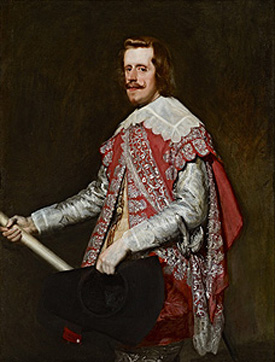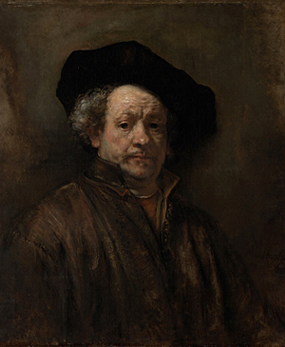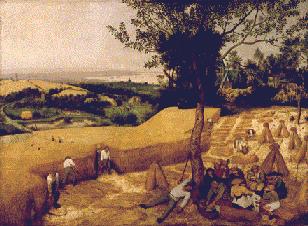Out to Impress
John Haberin New York City
Diego Velázquez: Francesco I d'Este
The Met's Galleries for European Painting
Someone was out to impress. Francesco I d'Este, for one, was in Madrid in 1638 seeking support.
By then, the Thirty Years' War had shifted from a religious war over the Reformation to a clash of dynasties and empires. By its end, in 1648, it had lain waste to much of Europe.  It had also cemented Dutch independence, the foundation of the age of Rembrandt. Francesco, duke of Modena since 1629, hoped mostly to retain a modicum of power and control amid shifting alliances. King Philip of Spain, a middling conflict manager but a terrific patron of the arts, wanted even the smallest advantage he could get. He treated his visitor royally.
It had also cemented Dutch independence, the foundation of the age of Rembrandt. Francesco, duke of Modena since 1629, hoped mostly to retain a modicum of power and control amid shifting alliances. King Philip of Spain, a middling conflict manager but a terrific patron of the arts, wanted even the smallest advantage he could get. He treated his visitor royally.
The result was a singular display of style and reserve. Francesco stayed at the Buen Retiro, the official residence where, the Met notes, he could admire quite an art collection. By the end of October, more than halfway into a six weeks' stay, he was viceroy of Catalonia, an Admiral of the Fleet, a member of the Council of State, and recipient of the Order of the Golden Fleece. He had also sat for an equestrian portrait by the court painter, Diego Velázquez. The juicy details have survived thanks to the Modenese ambassador, a poet and man of many words named Fulvio Testi, who complained of the artist's "defect of never finishing and not telling the truth." Francesco left with only a bust-length portrait, but it would have to do.
It is also an excellent reason to check out the Met's new galleries for European paintings. Along with a fresh display not long ago of other portraits by Velázquez in New York, it fills out the collection's strengths. On loan from Italy, it gives an impressive picture of what was at stake in politics and portraiture. As for its temporary home, I trust that you will find those galleries spectacular. I hope, too, that you will find them at least a little bit familiar. Let me introduce you first, though, to Francesco.
Show-off and reserve
Like him, the portrait is making only a short trip, as the Galleria Estense slowly recovers from another devastation—the May 2012 earthquake in Emilia Romagna. It gets a room to itself, with equal parts text for the damage on gray walls, for the collection in Modena, and for the portrait commission, with maybe a word toward the end about art. It also complements the ample choices of Velázquez in New York (and do not forget the Hispanic Society in Harlem). As the Met's director, Thomas Hoving's 1971 acquisition of Juan de Pareja was his most striking legacy, give or take the allure of museum blockbusters. Less convincingly, the museum recently upgraded a perfectly decent portrait to a genuine Velázquez, but this is the real thing.
Velázquez traveled, too, to Italy in 1629 and 1630, and he returned with new vigor. He already knew Italian and Flemish art at first hand thanks to the royal collection, including Peter Paul Rubens, who offered a model for his equestrian portraits of first Philip III and then Philip IV around 1635. Now, though, he was taking liberties. The stern or even cruel particularities of early Velázquez were giving way to a greater ease with his sitters, from deeply sympathetic encounters with dwarfs and a half-caste like Juan to a king's smile and the embroidery he wore, in quick curls of white. It is hard not to speak of Velázquez, or for that matter Spanish portraiture, without the word reserve, but he was well capable of showing off—with the pageantry of ordinary men in The Surrender at Breda, the Rokeby Venus before a mirror, and later the mirrors and mysteries of the entire Spanish court in Las Meninas, as enigmatic as in photographs after the painting by Yasumasa Morimura today.  With the duke of Modena, he shows how he pulled off both the pageantry and the reserve.
With the duke of Modena, he shows how he pulled off both the pageantry and the reserve.
The Met's more dubious portrait, from around 1630, all but boasts of its slapdash execution, from wisps of facial hair to the shadows under the eyes. Here the duke's calm is the still point of the entire composition. Only it takes time to get there, past a knotted red sash, shining armor, and that Order of the Golden Fleece. The red brings wide highlights and deep color (where I can only wish I had a name for it), the armor sudden and unexpected points of light. The Order is all but illegible, a show of the brush or maybe palette knife. It also allows one to date the composition to the final two weeks of Francesco's stay, when he received a nation's highest honor. Maybe Velázquez had to add it at the last moment.
The contrast between face and foreground does not divide the painting, as if the artist had delegated one or the other to his workshop. Rather, the painting's very extravagance heightens the precision at its center, much as for Anthony van Dyck. It also makes the separation of the face from the viewer part of the sitter's dignity, character, and reserve. A white spot on Francesco's nose and the white fabric of his collar helps bridge background and foreground—and a tiny dot of color alongside the white in his black eyes lends them depth. Along the sash and the armor, the brush follows repeatedly the contours of light and surfaces. With Francesco, it penetrates his eyes, to the point that one may look closer for the painter's reflection as in a mirror.
One will not find it there, but Velázquez gives the dark-haired sitter a reflective portrait. Francesco, still in his twenties, could be wearing armor at his request or the king's, but he does not carry a weapon, and he need not lift a hand to fight. The armor could mark him as a warrior as well as ruler in time of war, much like the lance for Philip IV in the Frick six years later. It could instead identify the portrait as a mere study, for the equestrian painting never completed. I like to think of it as a stylish Italian's concession to the Spanish fashion for black. He still gets his red sash, and he got to take home a polished, fully independent painting.
At least I think so. The ambassador may have lost patience, but Velázquez kicked out quite a body of work in those days. Born in 1599, he slowed down considerably in his forties, to barely two paintings a year, but I hardly know how he kept up his pace in the 1630s. One cannot say anything about his intentions for certain, not even knowing whether to call this portrait finished. Still, once one reaches the face, one is not likely to leave. Finished or not, this artist knew when to stop showing off.
After blockbusters
As for the Met's galleries for European painting, you will still meet Giovanni Battista Tiepolo at the head of the stairs, for those who believe that a museum deserves a palatial staircase—and a palatial staircase deserves the grand manner of eighteenth-century Venice. Beyond, you can still enter through this art's very origins, in Italy around 1300, or turn to the right, for much of the Baroque.  I had seen some impressive blockbusters in the twelve rooms to the left, but I always found a familiar face on the way out in Peter Paul Rubens. His family portrait shows a gentle side to his confidence and warmth, and it has moved no further than the opposite wall. It always brought me back to earth, and besides children should always be kept on a leash like his.
I had seen some impressive blockbusters in the twelve rooms to the left, but I always found a familiar face on the way out in Peter Paul Rubens. His family portrait shows a gentle side to his confidence and warmth, and it has moved no further than the opposite wall. It always brought me back to earth, and besides children should always be kept on a leash like his.
Of course, when I say familiar, I also mean that I hope you were looking forward to the reopened galleries, to catch up with old friends. They might be the hoary textbook cases, like The Death of Socrates by Jacques-Louis David, the mythic landscapes of Nicolas Poussin, or enough Rembrandt to fill a room together with Frans Hals—with more still to come. I visited the Met last summer for just one painting, perhaps to glimpse the mysterious older brother of Jan van Eyck. Mostly, though, I mean that this is the first new installation in over forty years, and yet it still wants you to feel at home. This is not about reinventing the whole idea of Western art, the way the Met's Islamic wing looks beyond even Islam. It does not find a new center, like the American wing in 2012, or stick the unexpected in your face, like the schlock lining the front hall for the nineteenth century.
Still, it is more than spectacular enough, with some seven hundred works in forty-five rooms, without even intruding more on Central Park. The blockbusters got started when the Impressionists moved out of their twelve rooms, and at last northern Europe has moved in. It means that you have a choice going forward not of north and south, but of two rivals for the birth of the Renaissance in Italy. An intimate Madonna and Child by Duccio welcomes one to Sienna, as a reminder that he was far more than a whipping boy for Giotto in Florence. It means that the Northern Renaissance, too, looks richer, with a room just for Hans Memling and Memling portraits, Rogier van der Weyden, and others—enough to make you feel that you have entered an entire culture. With the rest of added rooms given to Dutch painting, you can also now see a direct line to that culture's future.
Quite generally, where the old installation ran almost strictly by chronology, this one wants to create a sense of time and place. The Dutch have a room for decorative arts almost like a period room, where the reading room for blockbusters used to be, while Harvesters by Pieter Bruegel has a wall to itself. Italy hangs together, from the Renaissance to Baroque and Rococo. It takes just two rooms to get from El Greco and his View of Toldeo to Francisco de Goya in Spain. And the first follows Raphael, Bronzino, Bronzino portraits, and central Italy, so that one can see El Greco in a context of Mannerism.  The room for the loan from Italy by Velázquez (and, before that, for loans from Bergamo) is now dedicated to temporary exhibitions, so such contexts will grow and change.
The room for the loan from Italy by Velázquez (and, before that, for loans from Bergamo) is now dedicated to temporary exhibitions, so such contexts will grow and change.
The Lehman wing has not been broken up, that place where Cristóbal de Villalpando and art history go to die, nor the Linksy collection, where decent painting hardly even lived. They both remain a floor or two away, as tributes to a donor's ugly vanity. Still, the Met borrows from itself, most strikingly with Simone Martini from Robert Lehman. Hung next to another large saint from around 1300, one can imagine a path from their somber quiet all the way to Piero della Francesca. Within the galleries, the Benjamin Altman collection is now more fully integrated, so that all five paintings by Jan Vermeer hang together. For a larger group of Dutch painting, one may have to go to Amsterdam.
The museum also borrows from others, mostly private collections, so one can look for new friends. To name just two, Jusepe de Ribera gives a Jesuit's red and black cloak crispness and depth, while his Saint Peter and Paul are lost in conversation or debate. Sandro Botticelli has a Holy Family bursting into the third dimension and with a sudden vision of Saint Francis in the distance, added by the workshop. Another loan helps with the relatively weak holdings by Caravaggio—and while it lacks his usual psychology and drama, it probably just goes to show his debt to the Carracci brothers in Bologna. Some paintings have been cleaned, while more have acquired new frames, like the boxy frame for a Rubens in place of one more ornate, and almost every painting now has wall text. The labels may insist a little too hard on the curator's attributions, and they have at least one too many extraordinary or exquisite in place of explanation, but for now one may as well revel in the adjectives.

The portrait of Francesco I d'Este by Diego Velázquez ran at The Metropolitan Museum of Art through July 14, 2013. The Met's galleries for European paintings reopened May 23. Related reviews compare those other possible Velázquez portraits in New York and catch up with loans to the new wing of Piero della Francesca.




